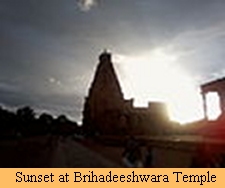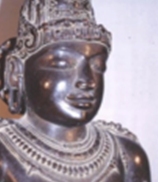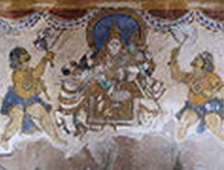
|  |

|  |
Politics touches even the 1000 year old Brihadeeswara Temple - Shanta Serbjeet Singh, New Delhi e-mail: shanta.serbjeetsingh@gmail.com September 15, 2010 The 1000th anniversary of the founding of Brihadeeswara, the great temple at Thanjavur, one of the three Chola temples of Southern India, was just a few days ago. Officially, the Tamil Nadu government will celebrate it on September 24th and 25th. And yet, despite the importance of Brihadeeswara as the symbol of the purest form of the Dravida style of temple architecture, nothing has appeared so far about it in north Indian print media or on television!  Here is the first great example of the triad of Chola temples, an exceptional and most outstanding testimony to the development of the Chola Empire and the Tamil civilisation in Southern India. Also known as Rajarajeswaram, this is the world's first complete granite temple and a brilliant example of the major heights achieved by the Cholas in temple architecture. As one of the greatest glories of Indian architecture, the temple is part of the UNESCO World Heritage Site. It is also a tribute and a reflection of the power of its patron Raja Raja Chola I. And yet we, in the north, have still to hear a whisper about what could be a spectacular celebrational exercise, bigger even, or at least comparable, to the opening of the Commonwealth Games. Imagine the scene with 1000 classical dancers from all parts of the country, led by Padma Subrahmanyam, herself an icon of Tamil civilization and one of its most distinguished symbols, that of Bharatanatyam. All of them will gather to mount a homage to Shiva, the Nataraja and Lord of Brihadeeswara! Many other events are also on the anvil, from Nagaswaram concerts to Thirumurai singing by 100 Oduvars, the exponents of Thevaram and Thiruvasagam. But the dance would be a sight for the gods themselves! And yet the political press did bite into the news, even if obliquely! Tamil Nadu Chief Minister and DMK supremo M Karunanidhi's gesture of sending a high-level team led by the state education and archaeological minister Thangam Thennarasu to meet Narendra Modi in Gandhinagar on Monday in connection with this event has created a flutter in Congress circles in New Delhi. To begin with, one can't pretend to be surprised that Tamil Nadu's ruling Dravida Munnetra Kazhagam and its leader, the one and only Karunanidhi, would not have made full use of the millennium event as a symbol par excellence of Tamil culture. According to reports, he is apparently disenchanted with the Congress-led United Progressive Alliance government and is not averse to exploring its fortunes by tying up with former ally the Bharatiya Janata Party, thanks to a little help from Gujarat Chief Minister Narendra Modi. The Thangam delegation is reported to have conveyed Karunanidhi's greetings to Modi and invited him to join the millennium celebrations! It also sought Modi's help in procuring and restoring in the temple, a bronze statue of the famed Chola emperor Rajaraja I who built the temple and died in 1014 AD, as also a statue of his queen Lokamadevi.  Raja Raja Cholan  One of the many frescos found in the pillared cloister But, and this is a massive 'but', both the statues are currently showcased in Ahmedabad, in the privately managed Sarabhai Foundation-run Calico Museum of Textiles. And we all know what the politics of the Sarabhais are vis-a-vis the BJP! Though Karunanidhi has already written to Modi seeking his help in 'bringing back home' the 11th century statues that were acquired in the 1940s by the Sarabhai Foundation trustee Gautam Sarabhai, it is not likely to be a smooth sailing, even with the help of Modi. And yet the temple, completed in AD 1010 needs to be celebrated for more reasons than one. According to historian Kudavayil Balasubramaniyan, an inscription found in a mandapam located on the western side of the Brihadeeswara temple says that Thennavan Moovendha Velan, who was appointed the chief administrative officer of the temple by Rajaraja Chola, had made statues of the emperor and his queen Lokamadevi. The historian also says the descriptions and measurements of the statues mentioned in the inscription match those kept in the Ahmedabad museum. In Indian Bronze Masterpieces published by the Festival of India in 1988, former Tamil Nadu archaeology director and noted archaeologist Dr. R Nagaswamy claimed that the two other bronze portraits in the Ahmedabad museum also relate to the same Chola kingdom. One is of the royal personage standing with flowers in hand and the other is of the king, both belonging to the age of Rajaraja Chola, circa 1010 AD. Let us now see whether the statues find their way back 'home'!  Shanta Serbjeet Singh, for twenty-five years, columnist, critic and media analyst for The Hindustan Times, The Economic Times and The Times of India, is the recipient of the Lifetime Achievement Award of the Sangeet Natak Akademi and Delhi Govt.'s Sahitya Kala Parishad for her contribution to the field of culture. She just finished her term as Vice Chairman of the SNA, is the founder-secretary of the World Culture Forum and continues as Chair of the UNESCO created NGO APPAN (The Asia-Pacific Performing Arts Network), a position to which she was appointed in 2001. Singh has authored several well-known publications such as 'Indian Dance: The Ultimate Metaphor' (published by Ravi Kumar (Paris), 'The 50th Milestone: A Feminine Critique' (Sterling Publishers, to mark India's fiftieth anniversary of Independence), 'Nanak, The Guru' (Oxford University Press) and 'America and You' (22 editions). |